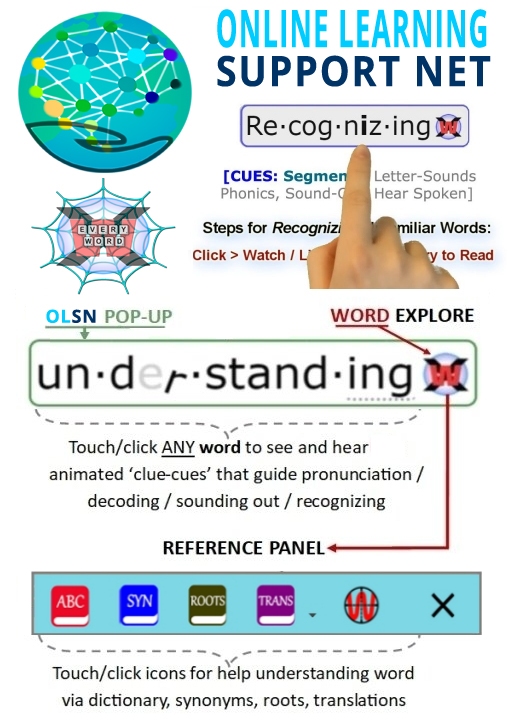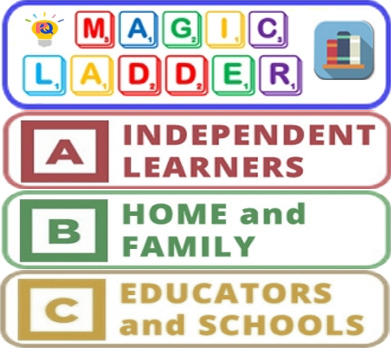Dyslexia
Note: Remember to click on any word on this page to experience the next evolutionary step in technology supported reading.
Percentage of Kids with Dyslexia
When we look at the kids who are having a tough time learning to read and we went through the statistics, thirty-eight percent nationally, disaggregate that, seventy percent of kids from poverty and so forth hit the wall. Ninety-five of those kids are instructional casualties. About five to six percent of those kids have what we call dyslexia or learning disabilities in reading.
G. Reid Lyon, Past- Chief of the Child Development and Behavior Branch of the National Institute of Child Health & Human Development, National Institutes of Health, Current senior vice president for research and evaluation with Best Associates. Source: COTC Interview – http://www.childrenofthecode.org/interviews/lyon.htm#Instructionalcasualties
Dyslexia Numbers
David Boulton: You’ve been attributing that up to twenty percent of the population has or could have dyslexia.
Dr. Sally Shaywitz: Right.
David Boulton: When we talked with Reid Lyon and James Wendorf, they’re very clear in the way that they frame it, coming at it from two different but correlated angles, that only about five to six percent of children, according to all of their studies and information, have anything that might be considered neurobiological in origin that’s impeding their learning to read; that for ninety-five percent of the children that are in various stages of struggle, that struggle has to do with how it is we are meeting them, teaching them, unfolding this before them; and that as a consequence, if we take your twenty and overlay it on that, there’s a kind of a definitional confusion.
Are you saying that twenty percent have an inherent problem with dyslexia, or that what we call dyslexia, which is such a general and broad term, stretches across twenty percent, part of which is neurobiological and part of which is instructional?
Dr. Sally Shaywitz: That’s an empiric question. We don’t know the answer to that. But if I were to come down on it, I would say that it would be just what we reported when I was telling you about the two-thirds and one-third. So I would, I think…
David Boulton: Basically, that actually brings it right back into alignment, right?
Dr. Sally Shaywitz: Exactly.
David Boulton: Okay. That’s what I thought. I just wanted to make sure we explicitly went through that loop together.
Dr. Sally Shaywitz: Right. And we don’t know. That’s why we’re carrying out genetic studies, to really see the differences.
David Boulton: They’ve backed into their five to six percent numbers; they’re not bottoms-up, right?
Dr. Sally Shaywitz: I don’t know where they — I think they got their number because what’s been shown is if you give children highly effective, evidence-based intervention you can bring down the number of struggling readers to five to seven percent.
David Boulton: Right. But that’s what I mean, they’ve backed into saying how many people might have neurobiological problems.
Dr. Sally Shaywitz: Yes.
Sally Shaywitz, Pediatric Neuroscience, Yale University, Author of Overcoming Dyslexia. Source: COTC Phone Interview – http://www.childrenofthecode.org/interviews/shaywitz.htm#DyslexiaNumbers
Dyslexia is the Biggest Learning Disability
Information processing really is an issue that cuts across so many different disabilities. The term “learning disabilities” is itself an umbrella term that encompasses a wide range of disorders and problems, the biggest one being dyslexia or reading disability.
James Wendorf, Executive Director, National Center for Learning Disabilities. Source: COTC Interview – http://www.childrenofthecode.org/interviews/wendorf.htm#LearningDisabilities
Seventy to Eight Percent of Students with Learning Disabilities Have Reading Based Learning Disabilities
Reading is the gateway skill. It leads to all sorts of success, both academically and in life. It is the skill that undergirds most of the curriculum, and if children aren’t learning that skill by the end of third grade, they are in desperate trouble. For kids with learning disabilities it’s a double whammy. You know, seventy to eighty percent of students with learning disabilities have their main problem in the area of reading, with reading based learning disabilities.
James Wendorf, Executive Director, National Center for Learning Disabilities. Source: COTC Interview – http://www.childrenofthecode.org/interviews/wendorf.htm#ReadingistheGatewaySkill
Dyslexia is Real
Over the past ten years we’ve learned that learning disabilities are real. For those who ever doubted, it’s absolutely apparent now in the science that learning disabilities are real. The brain research and the fMRI research showing images of the brain at work reveal conclusively that dyslexia and reading disabilities are real. We understand where in the brain the problem is and the functioning that is not happening in those who are experiencing that disorder.
James Wendorf, Executive Director, National Center for Learning Disabilities. Source: COTC Interview – http://www.childrenofthecode.org/interviews/wendorf.htm#WhatWeHaveLearned
Dyslexia is an Expected Problem
We’re saying that it’s a miracle that it ever happens. It’s an incredible human capacity. It’s hard won by incredible depth of practice. It’s very unsurprising that many people struggle with it. I mean, you wouldn’t have to have much of a fault in this machine operating with high speed in this incredible processing efficiency that’s required to begin to see somebody be a little slower at it or a lot slower at it.
And so therefore, dyslexia, in a self-organizing machine of this nature, is an expected problem. It’s an expected weakness. It should apply very widely.
Michael Merzenich, Chair of Otolaryngology at the Keck Center for Integrative Neurosciences at the University of California at San Francisco. He is a scientist and educator, and found of Scientific Learning Corporation and Posit Science Corporation. Source: COTC Interview – http://www.childrenofthecode.org/interviews/merzenich.htm#CodeAmbiguity
Dyslexia Robs a Person of Time
Dr. Sally Shaywitz: If somebody needs glasses, you wouldn’t question it, or if a diabetic needs insulin, in the same we know that children, or young adults and adults who have reading problems require extra time. For me, as a physician and as a scientist, one of the most exciting things has been that we’ve been able to now demonstrate that in children who are dyslexic, they don’t develop that word forming area, but they do develop compensatory regions, on the right side of the brain and also in the front, that allow them to read, but not automatically so that they can become highly accurate readers, but by the investment of an extraordinary amount of time and energy. They can get there, but their route is much slower and more inefficient.
David Boulton: Right. There’s some kind of a circuit detour that’s had to happen for them.
Dr. Sally Shaywitz: Exactly.
David Boulton: Which is slower in processing and results in them needing more time to be as effective in the task.
Dr. Sally Shaywitz: Right. What I say now is that dyslexia simply robs a person of time, accommodations like extra time return part of it, and that a person who is dyslexic has as much a physiologic need for extra time as a diabetic needs for insulin.
Now that we can show that with our brain imaging, that’s made an extraordinary difference. Because I’ve seen too many young people who were applying to graduate school or professional school who struggled their lives to reach the point where they can read accurately, but not automatically, are turned down for extra time. It’s like somebody climbing to the top of a mountain and you suddenly step on their fingers, and don’t let them take that last step, and knock them down. So it may not sound like an important thing to you, but for all those people who have had difficulty reading it is.
Sally Shaywitz, Pediatric Neuroscience, Yale University, Author of Overcoming Dyslexia. Source: COTC Phone Interview – http://www.childrenofthecode.org/interviews/shaywitz.htm#SlowReaders
Difference in Processing Rates
John Stein at Oxford has also really developed this magno cellular deficit hypothesis which is one of the focuses right now in dyslexia research at the more physiological level. And it fits very, very well with the temporal spectral processing deficit. In fact, many of the current theories have in common that there seems to be some underlying difference in the processing rates of the individuals with difficulty in processing rapid transient information.
Joe Talcott and Carolyn Whitten and various other people who are in John Stein’s lab at Oxford have published some wonderful papers in the proceedings of the National Academy of Sciences recently, I think in 2000, that really fit well with the study I talked about with infants. Basically, it showed that the ability to process transient visual and/or auditory information is very highly correlated across the spectrum of individual differences and different levels of reading ability.
Paula Tallal. Board of Governor’s Chair of Neuroscience and Co-Director of the Center for Molecular and Behavioral Neuroscience at Rutgers University. Source: COTC Interview – http://www.childrenofthecode.org/interviews/tallal.htm#NeuroanatomyofReading
Former Dyslexic Governors and Life-Long Shame
I think the low self-esteem, the sense of shame, is life-long. At the National Center for Learning Disabilities, we have a wonderful Board of Directors. We have at least two individuals on that board, both of whom have dyslexia and both of whom are former governors. They are extraordinarily accomplished individuals, both of them dyslexic. And both have talked at length about the continuing sense, not just of frustration or memories of failure, but precisely a sense of shame that is still remembered… classroom based, other children around, a teacher, not being able to do what other children seem to be able to do so easily. It stays for a lifetime. (More Shame Stories)
James Wendorf, Executive Director, National Center for Learning Disabilities. Source: COTC Interview – http://www.childrenofthecode.org/interviews/wendorf.htm#SelfEsteemShame
Pain Carried as a Burden
I once asked a very prominent American, very successful individual, one of the hundred most wealthiest Americans, why, given his great individual success, he felt investing in dyslexia related research was so important? Why did he cared so much? It was clear immediately when the question was asked, why he cared so much. He still felt the pain of self-identifying as a kid as a failure and of perhaps that self-identification more than his good parents was still carried as a burden by him later in life. (More Shame Stories)
Michael Merzenich, Chair of Otolaryngology at the Keck Center for Integrative Neurosciences at the University of California at San Francisco. He is a scientist and educator, and found of Scientific Learning Corporation and Posit Science Corporation. Source: COTC Interview – http://www.childrenofthecode.org/interviews/merzenich.htm#EmotionalDimensions
Disabilities: Neurobiological or Acquired?
It’s important to us to use the “disability” word non-metaphorically. That’s why I see myself pushing back on a couple of your questions regarding “acquired” disabilities. The neurobiological nature of learning disabilities is rooted in science, and also provides the foundation for federal protections and opportunities (flawed though they may be). Saying that millions more children are “disabled” due to instructional malfeasance is not something we would say or encourage. That said, there is considerable evidence that a percentage of children (hard to specify) are being labeled “learning disabled” simply because they have not been taught effectively.
I encourage you to establish and maintain a distinction between reading difficulty/problem and reading disability/disorder. As we discussed in the interview, many millions of kids struggle to read and learn, but a smaller number will truly qualify as having dyslexia/a reading disability.
James Wendorf, Executive Director, National Center for Learning Disabilities. Source: COTC Interview – http://www.childrenofthecode.org/interviews/wendorf.htm#Postscript
Early Era of the Study of Dyslexia
This really goes back to the basic arguments that were made at the early era of the study of dyslexia, by Isabelle Lieberman and others, who argued that the fundamental problem is the degraded way in which a person’s speech represents this crucial phonemic information. It is representing it in a fundamentally degraded way but it is subject to refinement. You could say the engrams, or the story representations of information that are the basis of usage, are in a fuzzier, degraded form. It’s an old idea but it is exactly what we believe is happening because the speech model in such a brain is just not up to par in the early life of a child. It’s noisy and degraded. A brain that represents speech based upon a muffled model generates a processor idealized for processing muffled speech.
Michael Merzenich, Chair of Otolaryngology at the Keck Center for Integrative Neurosciences at the University of California at San Francisco. He is a scientist and educator, and found of Scientific Learning Corporation and Posit Science Corporation. Source: COTC Interview – http://www.childrenofthecode.org/interviews/merzenich.htm#NeuroplasticityandSoundRepresentations













